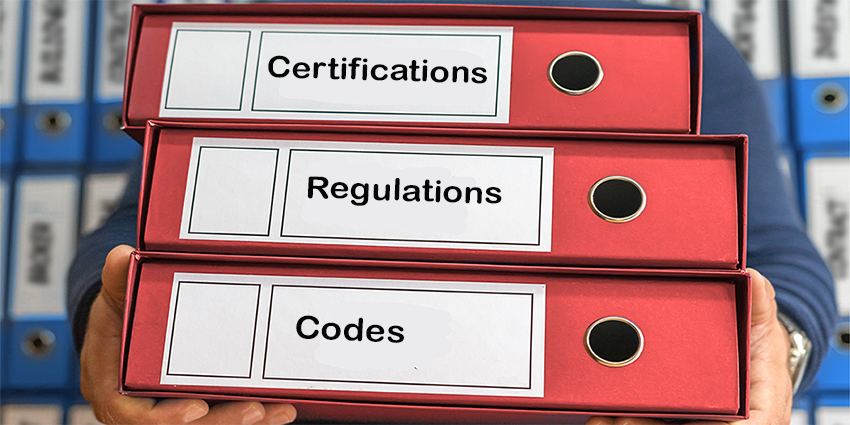Topic:
Codes/Standards
Certifications, Regulations, and Codes—What are they and why should I care?
|
January 11, 2022

Why do some HVAC products have several certifications depending on the application? Why do HVAC projects have some regulatory or code requirements that vary by equipment type and building, and are even specific to each system in a building? Shouldn’t similar products from competing manufacturers have similar or the same certifications, and comply with the same codes, and regulations?
Confusing? Difficult? Navigating the HVAC industry and its many certifications, codes, and regulations can be challenging. Many agencies and third-party organizations exist to regulate and test performance for the industry. The goal is safety and consistency when comparing HVAC products from different manufacturers. It does create confusion. However, you can avoid much of this confusion by working with manufacturers who take an active role with these agencies and the programs they develop to ensure product performance and safety.
Many manufacturers participate in such activities. For example, Greenheck participates in many industry and government initiatives related to certification, codes, and regulations. The following are a few of these initiatives.
Fan Energy Index (FEI)
FEI is a metric used to reduce electrical power in a fan system. The U.S. Energy Information Administration estimates that HVAC equipment consumes 16% of the electricity used in commercial buildings, indicating a significant opportunity to save energy.
Greenheck engineers played an instrumental role in developing the FEI metric and the standards defining how to calculate, test for, and certify FEI, working with the Air Movement and Control Association, International (AMCA). Other stakeholders, including the American Society of Heating Refrigerating and Air-Conditioning Engineers (ASHRAE), worked closely with our engineers to integrate FEI into ASHRAE 90.1, the benchmark for commercial energy codes.
Involvement by manufacturers in certifications, regulations, and codes drives meaningful change in our industry. It ensures that FEI and other metrics are in place to promote efficient fan selections that save energy and foster the development of more efficient fan designs. This involvement not only ensures we are moving the industry forward, but that we are also proactively developing products that will meet and exceed future requirements.
Safety and Building Resiliency
Many certifications, codes, and regulations focus on product safety. HVAC equipment can be installed in applications that have unique requirements. You may need products capable of exhausting hot, smoke-laden air during a fire. A health care facility in a region prone to earthquakes or high winds needs to operate during and after those events. Regulations and codes often define the minimum requirements of products for these applications. Additionally, certification and pre-approval programs exist to ensure products will meet those code and regulation requirements.
End-users look to Underwriters Laboratories (UL) for electrical safety, and safe operation in applications such as smoke control or restaurant exhaust. Manufacturers such as Greenheck take an active role in reviewing these standards and work with other manufacturers and trade associations to offer consensus recommendations. Collaborations with other manufacturers have resulted in test methods that ensure consistency with UL certifications regardless of manufacturer.
Building resiliency is a growing topic of interest in the HVAC industry. Building codes require minimum wind and seismic considerations in the design of buildings. The stringency of these requirements varies based on geographic location and the application. Two examples of more stringent requirements include the California Department of Health Care Access and Information (HCAI), formerly OSHPD, and Miami Dade County in Florida. Both have a pre-approval program addressing earthquakes and hurricanes, respectively. Manufacturers, including Greenheck, strategically pursue HCAI pre-approvals and NOA listings on products that work well in these extreme applications. Other products may have separate wind load designations or wind, or seismic calculations performed to demonstrate compliance with the International Building Code (IBC).
Experience with Codes, Regulations and Certifications
Manufacturers such as Greenheck have experience with and knowledge of the different safety and resiliency requirements, including pre-approval, certification programs, and code requirements. You can leverage this knowledge to help select the right product with the appropriate compliance for your project.
The HVAC industry and the certifications, regulations, and codes affecting the industry continue to evolve. You must be aware of the specific certification, regulatory, and code requirements of the project when specifying and then selecting equipment. The best way to accomplish this is working with a manufacturer who understands these requirements and can offer products that comply with them.
Have more questions about today’s building codes and regulations and their impact on your project? Connect with the exerts from Greenheck!
Codes/Standards
Confusing? Difficult? Navigating the HVAC industry and its many certifications, codes, and regulations can be challenging. Many agencies and third-party organizations exist to regulate and test performance for the industry. The goal is safety and consistency when comparing HVAC products from different manufacturers. It does create confusion. However, you can avoid much of this confusion by working with manufacturers who take an active role with these agencies and the programs they develop to ensure product performance and safety.
Many manufacturers participate in such activities. For example, Greenheck participates in many industry and government initiatives related to certification, codes, and regulations. The following are a few of these initiatives.
Fan Energy Index (FEI)
FEI is a metric used to reduce electrical power in a fan system. The U.S. Energy Information Administration estimates that HVAC equipment consumes 16% of the electricity used in commercial buildings, indicating a significant opportunity to save energy.
Greenheck engineers played an instrumental role in developing the FEI metric and the standards defining how to calculate, test for, and certify FEI, working with the Air Movement and Control Association, International (AMCA). Other stakeholders, including the American Society of Heating Refrigerating and Air-Conditioning Engineers (ASHRAE), worked closely with our engineers to integrate FEI into ASHRAE 90.1, the benchmark for commercial energy codes.
Involvement by manufacturers in certifications, regulations, and codes drives meaningful change in our industry. It ensures that FEI and other metrics are in place to promote efficient fan selections that save energy and foster the development of more efficient fan designs. This involvement not only ensures we are moving the industry forward, but that we are also proactively developing products that will meet and exceed future requirements.
Safety and Building Resiliency
Many certifications, codes, and regulations focus on product safety. HVAC equipment can be installed in applications that have unique requirements. You may need products capable of exhausting hot, smoke-laden air during a fire. A health care facility in a region prone to earthquakes or high winds needs to operate during and after those events. Regulations and codes often define the minimum requirements of products for these applications. Additionally, certification and pre-approval programs exist to ensure products will meet those code and regulation requirements.
End-users look to Underwriters Laboratories (UL) for electrical safety, and safe operation in applications such as smoke control or restaurant exhaust. Manufacturers such as Greenheck take an active role in reviewing these standards and work with other manufacturers and trade associations to offer consensus recommendations. Collaborations with other manufacturers have resulted in test methods that ensure consistency with UL certifications regardless of manufacturer.
Building resiliency is a growing topic of interest in the HVAC industry. Building codes require minimum wind and seismic considerations in the design of buildings. The stringency of these requirements varies based on geographic location and the application. Two examples of more stringent requirements include the California Department of Health Care Access and Information (HCAI), formerly OSHPD, and Miami Dade County in Florida. Both have a pre-approval program addressing earthquakes and hurricanes, respectively. Manufacturers, including Greenheck, strategically pursue HCAI pre-approvals and NOA listings on products that work well in these extreme applications. Other products may have separate wind load designations or wind, or seismic calculations performed to demonstrate compliance with the International Building Code (IBC).
Experience with Codes, Regulations and Certifications
Manufacturers such as Greenheck have experience with and knowledge of the different safety and resiliency requirements, including pre-approval, certification programs, and code requirements. You can leverage this knowledge to help select the right product with the appropriate compliance for your project.
The HVAC industry and the certifications, regulations, and codes affecting the industry continue to evolve. You must be aware of the specific certification, regulatory, and code requirements of the project when specifying and then selecting equipment. The best way to accomplish this is working with a manufacturer who understands these requirements and can offer products that comply with them.
Have more questions about today’s building codes and regulations and their impact on your project? Connect with the exerts from Greenheck!
Codes/Standards
Other Blog Topics


from